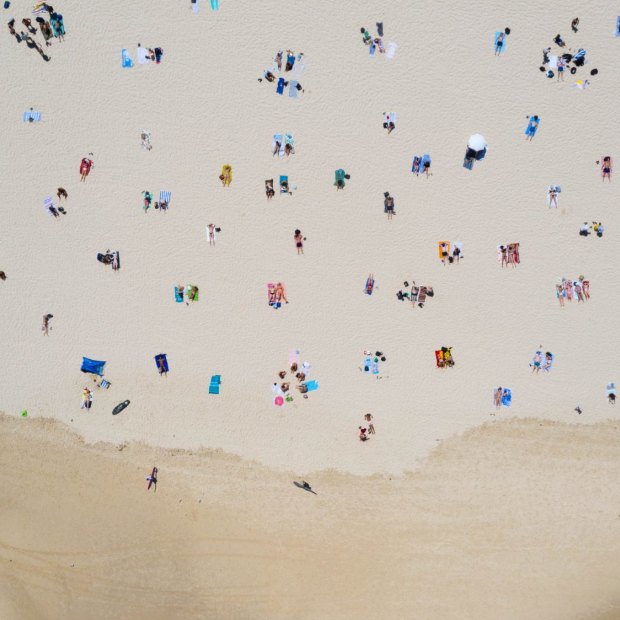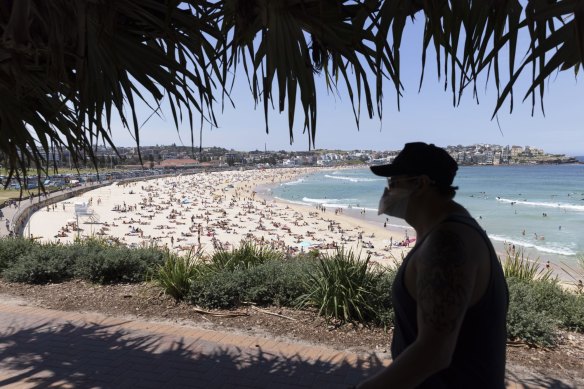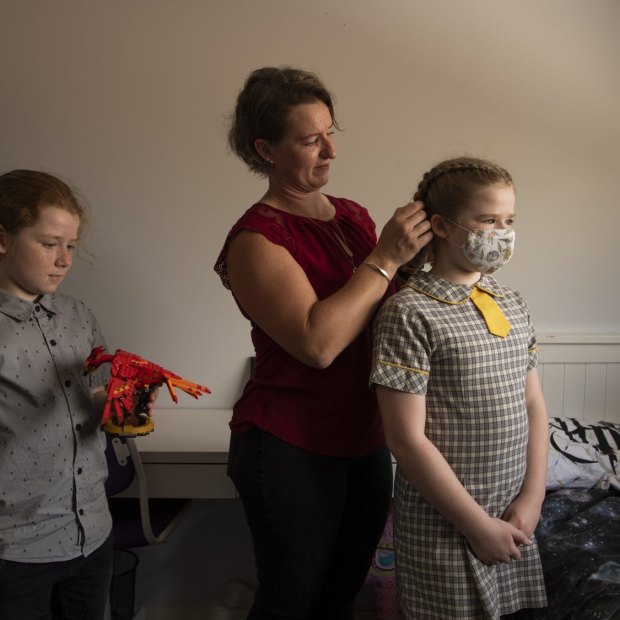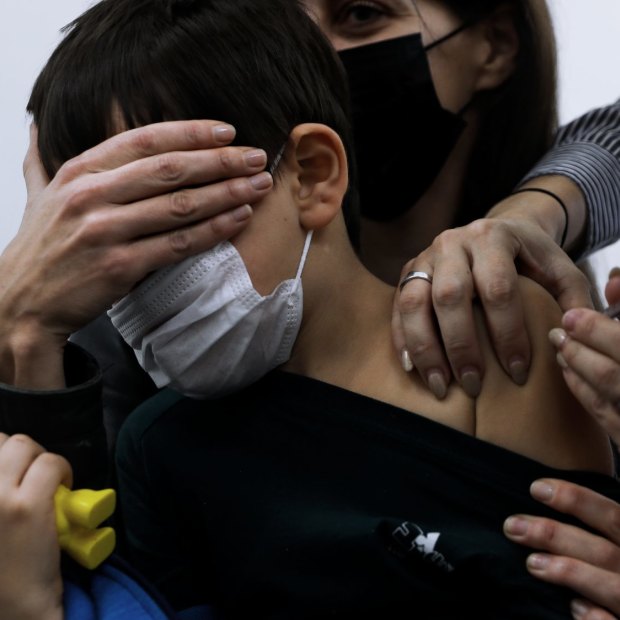This was published 2 years ago
‘Crunch time’: What to expect from Sydney’s Delta wave over summer
By Mary Ward

Swimmers at Bondi Beach adhere to social distancing recommendations on a warm Friday afternoon in Sydney. 4th December 2020 Photo: Janie BarrettCredit: Janie Barrett
On December 16, 2020 NSW health authorities alerted the public to two new coronavirus cases on Sydney’s northern beaches.
Within a week, the local government area was in lockdown and the rest of the city returned to restrictions it had been rid of for months. Families were separated for the summer holidays and the CBD closed to the public for New Year’s.
This year, December 16 will look very different: the second day of further eased restrictions in the state, with capacity limits for hospitality venues scrapped, the retirement of the Service NSW vaccination certificate and QR check-ins no longer needed in shopping centres.

Bondi Beach in the last week of Sydney’s lockdown, in October.Credit: Brook Mitchell
Sydney has been promised the summer it missed in 2020. Although nothing is certain in a global pandemic – this weekend a new Omicron strain has been identified as a variant of concern – this is what public health experts expect will follow.
Unvaccinated re-enter high-risk venues
NSW will lift restrictions that prevent people who have not received two doses of a COVID-19 vaccine from entering places such as restaurants, gyms and others’ homes on December 15.
Since reopening, these places have been sites of virus transmission. However, with attendees all protected by vaccination, case numbers in NSW have remained relatively stable and hospitalisations and intensive care admissions have declined.
Government and health authorities say they expect case numbers in the state to go up over summer, but the key metric of concern is now hospitalisations.
When NSW reopens, more than 93 per cent of its 16 and over population will be fully vaccinated. But what about that 7 per cent who aren’t?
“It’s not ideal. Because we are ‘shooting for the stars’ here in Australia,” says University of Sydney epidemiologist Professor Alexandra Martiniuk.

Schools are now a major driver of case numbers since the end of lockdown. The summer holidays could prove a respite from community transmission. Credit: Louise Kennerley
“It may cost lives. It may put the health system under more stress than otherwise. But the high vaccination rate means it is a reduced risk.”
The difference of a few percentage points is probably negligible, says James Cook University infectious diseases physician and mathematician Professor Emma McBryde, when herd immunity – 95 per cent of the total population vaccinated – is impossible due to the lack of an approved shot for children.
School holidays could help curb case numbers
Last year health authorities were raising concerns about the school holidays driving virus clusters through extended family gatherings and regional travel. But with high adult vaccination rates, schools are now a major driver of community transmission in NSW, meaning the holidays could be a welcome reprieve.
Since the start of November, data from NSW Health’s weekly COVID-19 surveillance reports show about a third of cases have been in children aged 11 and under, not yet eligible for vaccination. NSW Health has repeatedly asked parents to keep children with symptoms home from school, due to the number of school clusters that have developed since the return of in-person learning in October.
Professor Catherine Bennett, chair of epidemiology at Deakin University, says it is not as simple as saying kids are only catching the virus at school – research published earlier in the outbreak showed most COVID-positive children caught it at home – but it is a good sign for Australia that the northern hemisphere’s summer holidays resulted in lower case numbers.
“The virus has a few things working against it over summer; the weather is better, people are outside where they are less likely to catch COVID. But schools on break is also an important part of that,” she says.
Delta likely to remain dominant variant
Reopening to fully vaccinated arrivals from overseas and from Victoria, where the bulk of Australia’s infections are being recorded, has had minimal impact on NSW’s numbers. But could a new, more transmissible variant of the virus such as Omicron hit our shores, like Delta did in 2021?
Associate Professor Stuart Turville, who heads up the Kirby Institute’s research on COVID-19 mutations, says – although scientists are keeping a watchful eye for new variants developing in Africa – more than 98 per cent of coronavirus infections globally are the Delta strain already present in Australia, and that is likely to stay the same over summer.
While higher vaccination coverage in the population may result in higher numbers of “breakthrough” infections – cases in vaccinated people – if community transmission was to rise, Dr Turville says the available vaccines are still extremely effective.
“What we see in the lab and in the real world is the efficacy is holding up,” he says. “Yes, there will be breakthrough infections but the good news with those cases is they rarely get hospitalised.”
Vaccination for children aged five to 11
Earlier this month, the US became the first country in the world to approve Pfizer’s paediatric COVID-19 vaccine for use in children aged five to 11.
The Therapeutic Goods Administration and Australia’s vaccine advisory group, ATAGI, are currently considering whether younger children will be given the shot. They are waiting for real-world evidence out of the US to ensure the very rare incidences of vaccine side-effects (such as heart complications) do not outweigh the benefit of vaccination coverage in the age group, who largely only experience mild disease if infected with COVID-19. Federal authorities have said there is no plan for a rollout before January.
“The dream would be kids can get vaccinated in January, February before school goes back,” says Professor Martiniuk.

Israeli child Liam Lev Tov, 6, in the arms of his mother, receives a Pfizer vaccine. Credit: AP Photo/Oded Balilty
Modelling conducted by the Kirby Institute’s Biosecurity Program, led by Professor Raina MacIntyre and released this week, suggested that, while vaccinating children aged five to 11 would have a greater bearing on how many cases were recorded to June 2022, it was maintaining strong contact tracing practices – ideally getting to 80 per cent of cases within 24 to 48 hours of notification – that would help the state’s hospitalisations and ICU admissions remain at manageable levels.
Professor Bennett says case modelling can be flawed because it fails to account for changes in the public’s behaviour in an outbreak – or localised public health responses. However, she agrees hospitalisations are generally driven by adult infections, particularly those in older adults.
Contact tracing, QR codes scaled back
On Thursday, Premier Dominic Perrottet confirmed that from December 15 QR check-ins in low-risk settings such as retail stores will be scrapped, although they will still be needed in other venues, such as restaurants, gyms and hair salons.
“Contact tracing is important because the contacts are the most likely people to get infected after an infected case,” says Professor MacIntyre.
After initial suggestions NSW may do away with venue QR codes altogether, Professor Martiniuk says it is a good idea to keep some protocols in place.
“That’s a tenet that’s held in management of all infectious diseases – when we have measles, we contact trace, we issue alerts.”
In lieu of the long lists of exposure venues seen earlier in the Delta wave, Professor Bennett says local public health units will likely respond to high-risk outbreaks in a more tailored way.
For example, this week when an unvaccinated staff member at a Byron backpackers tested positive, NSW Health locked down the hostel for one week and provided vaccinations on-site, due to the risk of spread in a population with a vaccination rate below the state average.
February the ‘crunch time’
With children returning to school, a possible epidemic peak of infections, as well as slightly waning vaccine immunity for the rush of people who received the Pfizer vaccines which arrived en masse in the state in September, Professor MacIntyre says February is likely to be “crunch time” for COVID-19 in NSW.
But if practices like social distancing don’t fall by the wayside, vaccine uptake remains strong for boosters and the possible paediatric course, and La Nina doesn’t keep everyone inside, Professor Martiniuk says Australia could be a “miracle case” on the world stage.
Then there is what happens after summer has passed. Professor Bennett is optimistic, noting autumn – when cases began to rise again in the US and Europe – will coincide with the bulk of NSW’s booster doses being administered.
“That will be perfect timing. If we can get into autumn safely then we are in a prime position to keep the virus under control.”
Stay across the most crucial developments related to the pandemic with the Coronavirus Update. Sign up to receive the weekly newsletter.